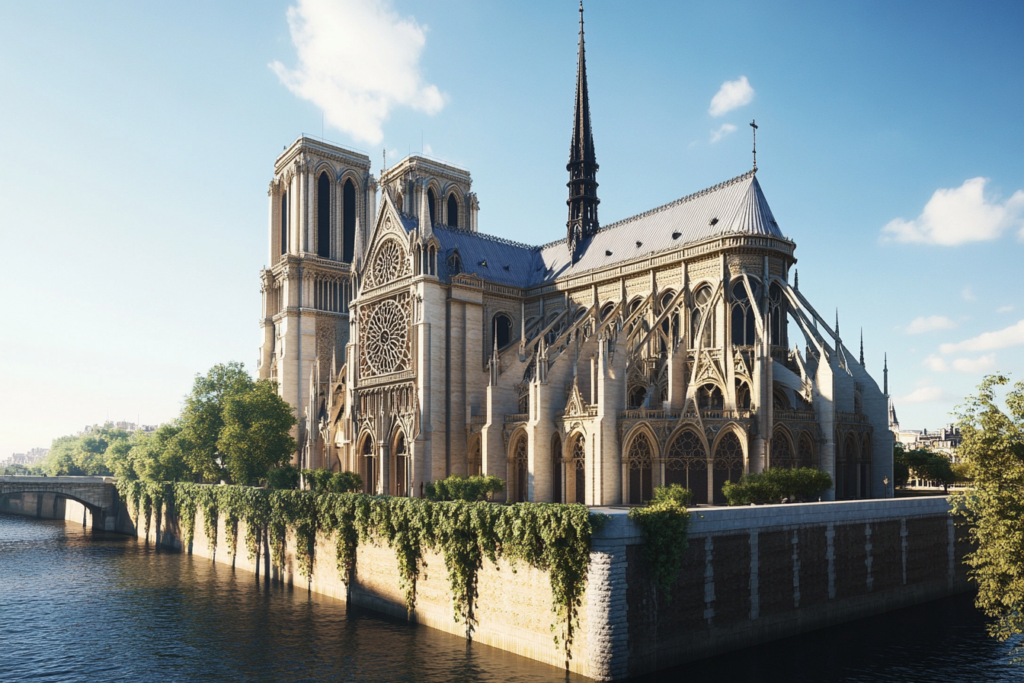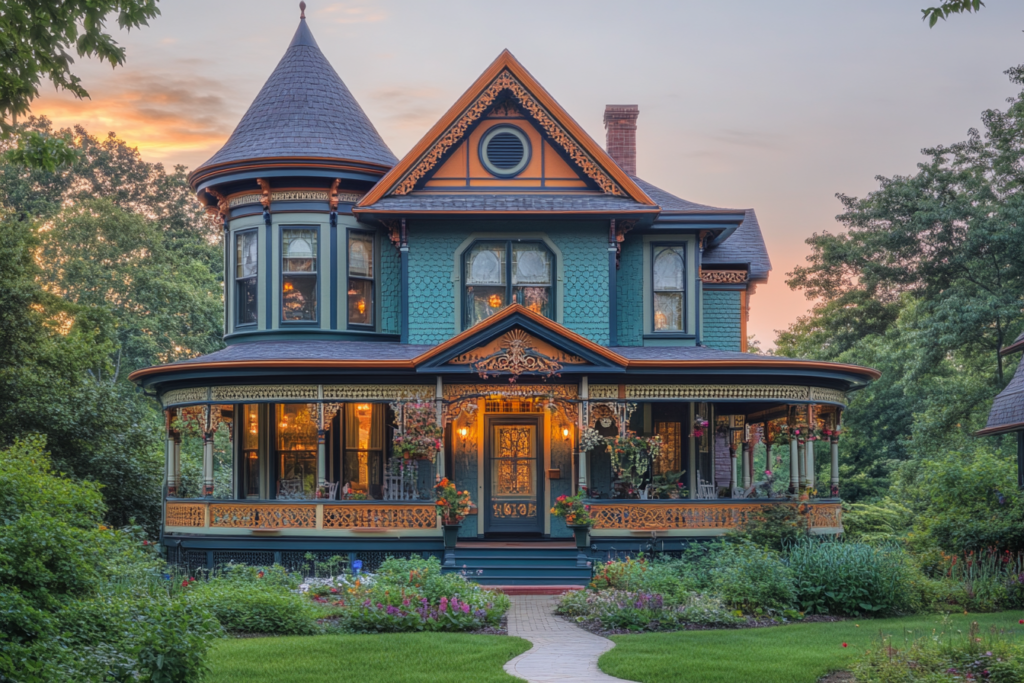Architecture & Design: A Journey Through History, Iconic Styles, and Current Trends
Welcome to the fascinating world of architecture and design! From ancient marvels to modern masterpieces, architecture tells the story of human civilisation through its evolving styles and innovations. This section delves into the rich history of architecture, explores important eras and genres, highlights iconic structures, and examines current trends shaping the built environment. Join us as we uncover why architecture and design are worth exploring and how they continue to inspire and shape our world.
History of Architecture: Building Through the Ages
Ancient Architecture: The Foundations of Civilisation
Egyptian Architecture
Egyptian architecture, renowned for its monumental structures, laid the foundations for architectural excellence. The pyramids of Giza, with their precise alignment and grandeur, are a testament to ancient engineering prowess. Temples such as Karnak and Luxor, with their massive columns and intricate carvings, showcase the Egyptians’ advanced understanding of geometry and symmetry. These structures were not only tombs and places of worship but also symbols of the pharaohs’ divine authority and the civilisation’s technological advancements. Their architectural feats demonstrate early mastery of stone construction and spatial organisation, revealing the Egyptians’ sophisticated approach to design and building.
Why Discover More: Understanding Egyptian architecture provides insight into early human ingenuity and the cultural significance of structures.

Greek Architecture
Greek architecture introduced the classical orders—Doric, Ionic, and Corinthian—that have influenced Western architecture for millennia. The Parthenon in Athens exemplifies the harmony and proportion central to Greek design. Other significant structures include the Temple of Hephaestus and the Theatre of Epidaurus, which highlight the Greeks’ mastery of acoustics and aesthetics. The emphasis on proportion, balance, and beauty has left a lasting legacy on architectural theory and practice, influencing public buildings, temples, and amphitheaters. The Greeks’ innovative use of columns, entablatures, and pediments set the standard for classical architecture and its enduring appeal.
Why Discover More: Greek architecture’s emphasis on form and function continues to inform contemporary design principles.

Roman Architecture
Building on Greek principles, Roman architecture advanced engineering with innovations like the arch, vault, and concrete. The Colosseum and the Pantheon stand as enduring symbols of Roman architectural ingenuity. Roman aqueducts and bridges, such as the Pont du Gard, also demonstrate their prowess in infrastructure development. The Romans’ ability to construct large, durable structures with sophisticated engineering techniques set the foundation for modern architecture and urban planning. Their architectural legacy includes roads, baths, and arenas that formed the backbone of Roman urban life, showcasing their expertise in creating functional and grandiose public spaces.
Why Discover More: Roman architecture’s legacy is seen in modern infrastructure and public buildings worldwide.

Medieval Architecture: From Castles to Cathedrals
Romanesque Architecture
Romanesque architecture, characterised by thick walls and round arches, was prevalent in Europe from the 9th to the 12th centuries. Notable examples include the Abbey of Cluny in France and the Speyer Cathedral in Germany. This style marks a transition from ancient to medieval building styles, highlighting the evolution of structural techniques. The robust and sturdy designs of Romanesque buildings were intended to convey strength and protection during turbulent times, reflecting the era’s socio-political landscape. Romanesque architecture is also noted for its use of semicircular arches, barrel vaults, and large towers, which provided both aesthetic appeal and structural stability.
Why Discover More: Romanesque architecture marks a transition from ancient to medieval building styles, highlighting the evolution of structural techniques.

Gothic Architecture
Gothic architecture emerged in the 12th century, emphasising verticality and light through innovations like the pointed arch, ribbed vault, and flying buttress. Notre-Dame de Paris and the Chartres Cathedral epitomise this style, with their soaring spires and intricate stained glass windows. The Gothic style sought to create a sense of awe and divine presence, transforming dark and heavy structures into ethereal and light-filled spaces. Gothic cathedrals were designed to inspire and uplift, reflecting the medieval quest for spiritual elevation. The intricate detailing, expansive windows, and towering heights of Gothic buildings symbolise the period’s artistic and engineering achievements.
Why Discover More: Gothic architecture’s focus on light and height created some of the most awe-inspiring religious structures in history.

Architecture from 1700 to 1900: Neoclassicism to Art Nouveau
Neoclassical Architecture: A Return to Order
Neoclassical architecture, prominent in the 18th and early 19th centuries, sought to revive classical Greek and Roman aesthetics. The British Museum in London exemplifies this style with its grandiose columns and symmetry. Other notable examples include the United States Capitol and the Brandenburg Gate in Berlin. Neoclassical architecture emphasised simplicity, order, and proportion, reflecting Enlightenment ideals of reason and democracy. This style became synonymous with civic pride and institutional authority, influencing the design of government buildings and cultural institutions. The adoption of classical elements, such as pediments and domes, helped convey a sense of timelessness and grandeur.
Why Discover More: Neoclassical architecture’s emphasis on simplicity and elegance remains influential in public and institutional buildings.
Alt Text: The British Museum in London, an iconic example of Neoclassical architecture with its imposing columns and symmetrical design.
Key Features and Examples
- Symmetry and Proportion: Inspired by the classical orders, Neoclassical buildings often feature symmetrical facades and balanced proportions.
- Prominent Columns: Large, imposing columns are a hallmark of Neoclassical architecture.
- Famous Examples: The British Museum (London), the Panthéon (Paris), and the White House (Washington, D.C.).
Victorian Architecture: The Age of Innovation
Victorian architecture, spanning the reign of Queen Victoria (1837-1901), is known for its eclectic mix of styles, including Gothic Revival, Italianate, and Queen Anne. This era saw the rise of elaborate ornamentation and innovative building techniques. Key examples include the Palace of Westminster and the Victoria and Albert Museum in London. The Victorian period was marked by rapid industrialisation and urbanisation, which influenced the ornate and decorative nature of its architecture. The diversity of styles and the emphasis on detail and craftsmanship reflect the era’s complex social and cultural dynamics. Victorian architecture also saw the introduction of new materials and technologies, such as cast iron and plate glass, which enabled more ambitious and elaborate designs.
Why Discover More: Victorian architecture’s diverse styles and decorative elements reflect the technological advancements and social changes of the era.

Key Features and Examples
- Ornamentation: Intricate details, including decorative trim, stained glass windows, and patterned brickwork.
- Variety of Styles: Incorporates elements from Gothic Revival, Italianate, and Queen Anne styles.
- Famous Examples: The Palace of Westminster (London), Osborne House (Isle of Wight), and the Carson Mansion (California).
Art Nouveau: The Art of Nature
Art Nouveau, which emerged in the late 19th century, is characterised by its use of organic forms, flowing lines, and natural motifs. Architects like Antoni Gaudí and Hector Guimard are renowned for their innovative and whimsical designs. Buildings such as the Sagrada Família in Barcelona and the Casa Batlló exemplify this style. Art Nouveau sought to break away from historical styles, embracing a new form of artistic expression that celebrated nature and creativity. The movement’s emphasis on craftsmanship and decorative arts led to the creation of unique and visually striking buildings, which often incorporated elements like floral patterns, curved lines, and elaborate ironwork.
Why Discover More: Art Nouveau’s emphasis on artistic expression and natural forms continues to inspire contemporary design and architecture.
Alt Text: The entrance to the Paris Métro, designed by Hector Guimard, showcasing the organic forms and flowing lines of Art Nouveau architecture.
Key Features and Examples
- Organic Forms: Inspired by nature, with flowing lines and natural motifs.
- Innovative Materials: Use of glass, iron, and ceramic tiles to create intricate designs.
- Famous Examples: Casa Batlló (Barcelona), the Paris Métro entrances, and the Secession Building (Vienna).
Architecture from 1900 to 2024: Modernism to Contemporary Trends
Modernism: Breaking Away from Tradition
Modernist architecture emerged in the early 20th century, rejecting ornamentation in favour of simplicity, functionality, and new materials. The Bauhaus School and Le Corbusier’s Villa Savoye are hallmark examples. Other significant buildings include the Barcelona Pavilion and the Farnsworth House. Modernism focused on the idea that form should follow function, leading to the creation of buildings that prioritised practicality and efficiency. The movement’s clean lines, open floor plans, and use of industrial materials revolutionised architectural design. Modernist architecture also embraced the concept of the “machine for living,” where buildings were designed to serve the needs of their occupants efficiently and elegantly.
Why Discover More: Modernism’s principles of form following function and the use of industrial materials have shaped contemporary architecture.
Alt Text: Villa Savoye in France, a symbol of Modernist architecture with its clean lines and open floor plans.
Key Features and Examples
- Functional Design: Emphasis on utility and simplicity, with minimal ornamentation.
- New Materials: Use of steel, glass, and concrete to create open and flexible spaces.
- Famous Examples: Villa Savoye (France), Bauhaus School (Germany), and the Seagram Building (New York City).
Mid-Century Modern: Sleek and Stylish
Mid-century modern architecture, popular from the 1940s to the 1960s, is known for its clean lines, organic forms, and integration with nature. Architects like Frank Lloyd Wright and Richard Neutra are iconic figures of this movement. Famous structures include Fallingwater and the Eames House. Mid-century modern design emphasised simplicity, functionality, and a connection to the natural environment. The style’s use of large windows, open spaces, and minimalistic decor created homes that were both stylish and practical. This era marked a departure from the ornate styles of the past, focusing instead on streamlined forms and innovative materials. The enduring appeal of mid-century modern design is evident in its continued popularity and influence on contemporary interiors and architecture.
Why Discover More: Mid-century modern design’s emphasis on simplicity and harmony with nature continues to influence contemporary architecture and interior design.
Alt Text: A mid-century modern home with large windows, clean lines, and a seamless integration with its natural surroundings.
Key Features and Examples
- Clean Lines: Simple, geometric forms with minimal decoration.
- Natural Integration: Use of large windows and open spaces to blend indoor and outdoor environments.
- Famous Examples: Fallingwater (Pennsylvania), Eames House (California), and Farnsworth House (Illinois).
Postmodernism: Embracing Complexity and Contradiction
Postmodern architecture, which rose in the late 20th century, challenged Modernism’s rigidity by reintroducing ornamentation, colour, and historical references. The AT&T Building in New York City, designed by Philip Johnson, epitomises this eclectic style. Other notable examples include the Portland Building and the Guggenheim Museum Bilbao. Postmodernism embraced a mix of styles and elements, often incorporating whimsical and playful features. This movement celebrated diversity and complexity, creating buildings that were rich in character and visual interest. Postmodern architects sought to create more humanistic and engaging environments, countering the perceived coldness and impersonal nature of Modernist architecture.
Why Discover More: Postmodernism’s playful and diverse approach encourages creative freedom in architectural design.
Alt Text: The AT&T Building in New York City, featuring a distinctive Chippendale-inspired top, exemplifying Postmodern architecture.
Key Features and Examples
- Eclectic Styles: Mix of historical references and modern design elements.
- Playful Ornamentation: Use of bold colours, decorative details, and unusual forms.
- Famous Examples: AT&T Building (New York City), Piazza d’Italia (New Orleans), and the Portland Building (Oregon).
Sustainable Architecture: Building for the Future
Sustainable architecture prioritises environmental responsibility through energy efficiency, renewable materials, and eco-friendly designs. The Bullitt Center in Seattle is a leading example of a net-zero energy building. Other important projects include the Bosco Verticale in Milan and The Crystal in London. Sustainable architecture aims to minimise the environmental impact of buildings by incorporating green technologies and sustainable practices. These structures often feature solar panels, green roofs, and rainwater harvesting systems, contributing to a more sustainable future. The principles of sustainable architecture also include passive solar design, natural ventilation, and the use of locally sourced materials to reduce carbon footprints.
Why Discover More: Understanding sustainable architecture is crucial for addressing climate change and promoting ecological balance.
Alt Text: The Bullitt Center in Seattle, a model of sustainable architecture with its green roof and energy-efficient design.
Key Features and Examples
- Energy Efficiency: Use of passive solar design, insulation, and energy-efficient systems.
- Renewable Materials: Incorporation of sustainable materials like bamboo, recycled metal, and reclaimed wood.
- Famous Examples: The Bullitt Center (Seattle), Bosco Verticale (Milan), and One Central Park (Sydney).
Smart Homes: Integrating Technology
Smart home design incorporates advanced technology for convenience, security, and energy management. Features include automated lighting, climate control, and security systems, enhancing the functionality of living spaces. Smart homes use IoT (Internet of Things) devices to create a connected living environment, where various systems can be controlled remotely or through voice commands. This technology allows homeowners to monitor and manage their energy usage, security, and home appliances efficiently. The integration of smart home technology also includes innovations like smart thermostats, home automation hubs, and energy-efficient appliances, making everyday living more convenient and sustainable.
Why Discover More: Smart home technology represents the future of residential living, offering enhanced comfort and efficiency.
Alt Text: A modern living room equipped with smart home technology, including automated lighting and climate control systems.
Key Features and Examples
- Home Automation: Systems that control lighting, heating, and security remotely or through voice commands.
- Energy Management: Smart thermostats and appliances that optimise energy use.
- Famous Examples: Bill Gates’ house (Medina, Washington), Smart Living Lab (Fribourg), and The Edge (Amsterdam).
Biophilic Design: Connecting with Nature
Biophilic design integrates natural elements into architectural spaces to improve well-being and productivity. Incorporating greenery, natural light, and organic materials, this approach fosters a deeper connection with nature. Biophilic design is rooted in the understanding that humans have an inherent need to connect with nature, which can be satisfied through thoughtful design. By bringing elements of the natural world indoors, biophilic design enhances the aesthetic and functional quality of a space while promoting health and wellness. This design approach also includes features like water elements, natural ventilation, and views of nature, which contribute to a calming and rejuvenating environment.
Why Discover More: Biophilic design enhances mental and physical health, making it a valuable approach for both residential and commercial spaces.
Alt Text: An office space featuring abundant natural light and indoor plants, illustrating the principles of biophilic design.
Key Features and Examples
- Greenery: Incorporate plants and green walls to bring nature indoors.
- Natural Light: Maximise daylight with large windows and skylights.
- Organic Materials: Use wood, stone, and other natural materials in construction and decor.
- Famous Examples: Amazon Spheres (Seattle), Changi Airport Terminal 4 (Singapore), and Bosco Verticale (Milan).
Minimalism: Less is More
Minimalist architecture and design focus on simplicity, clean lines, and uncluttered spaces. This trend emphasises functionality and the beauty of essential forms, as seen in the works of architects like Tadao Ando. Minimalism emerged as a response to the excesses of previous styles, advocating for a more pared-down approach to design. By eliminating unnecessary elements, minimalist design creates serene and orderly environments that promote clarity and focus. The principles of minimalism also extend to the use of a limited colour palette, natural materials, and open floor plans, creating spaces that are both functional and aesthetically pleasing.
Why Discover More: Minimalism’s focus on simplicity and clarity offers a timeless and serene aesthetic that can be adapted to various styles.
Alt Text: A minimalist living room with clean lines, neutral colours, and simple furnishings, showcasing the elegance of minimalism.
Key Features and Examples
- Simplicity: Focus on essential elements without unnecessary decoration.
- Neutral Palettes: Use of whites, greys, and other neutral tones.
- Open Spaces: Design that emphasises openness and flow.
- Famous Examples: Church of the Light (Japan), Farnsworth House (Illinois), and Barcelona Pavilion (Spain).
Conclusion: Why Explore Architecture and Design?
Discovering the history and trends in architecture and design enriches our understanding of cultural evolution and innovation. Each era and style offers unique insights into the values and technological advancements of its time. By exploring these topics, we gain a greater appreciation for the built environment and the creative minds that shape it. From ancient wonders to futuristic smart homes, architecture reflects humanity’s quest for beauty, functionality, and sustainability.
For more detailed explorations and related topics, visit our subsections on Ancient Architecture, Modernist Design, Sustainable Architecture, and Smart Home Technology. Dive deeper into the world of architecture and design and find inspiration for your own spaces.
Happy exploring!
Alt Text for Conclusion: An eclectic collage of iconic architectural landmarks from various eras, symbolising the rich tapestry of architectural history.
